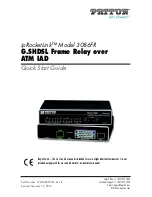
LTE Indoor CPE | User Manual
P. 33
802.11n is applied; select the bandwidth as required from the drop-down list.
•
20M – Setting the bandwidth to 20M.
•
20M/40M – The bandwidth setting will automatically be switched between
20M and 40M by CPE.
RTS Threshold:
RTS (Request-to-send) packets are a mechanism used by the
802.11 wireless networking protocols which establish an open communication to
an AP or node; it is a signal sent from the transmitting station to the receiving
station requesting permission to transmit. The range of RTS threshold is from 256
to 2432.
CTS Protect Mode:
Clear to send (CTS) protection mode is a wireless setting that
ensures computers on a network can connect to a wireless router when many
communications devices are present. When the setting is “Always On”, a computer
must receive a CTS frame from the wireless access point (WAP) before
information can be sent. An “Auto” setting determines which computer can reach
a WAP at a specific through a request to send (RTS) packet. If CTS Protect Mode
is “Always Off”, network computers may experience difficulty in reaching the
Internet as they all try to connect at the same time.
Preamble Length:
The preamble is the first part of the Physical Layer
Convergence Protocol/Procedure (PLCP) Protocol Data Unit (PDU); a length of null
signal before data. It gives time for receivers on the network to detect the signal
and prepare to receive the data. Short preamble takes less time to process and
minimizes overhead, so it should be used in a good wireless network environment
when all wireless clients support it; select
“Long”
if you have a 'noisy' network
environment which long preamble could provide more reliable communication.
SSID Broadcast:
Having SSID broadcast disabled essentially makes your device
invisible unless a wireless client already knows the SSID, or is using tools that
monitor associated clients. The default setting of SSID Broadcast is “Enabled”.
















































